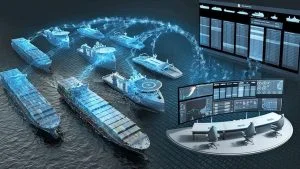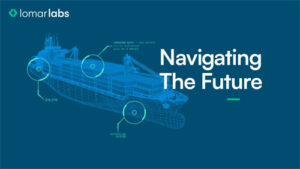Mythos AI and lomarlabs deploy “Sea-Pilot” AI assistance — what it is, how it works, and why it matters
Byline: Bits of us — September 16, 2025
Lead: Mythos AI and lomarlabs have begun piloting a next-generation navigation assistant — the Advanced Pilot Assistance System (APAS) — aboard the chemical tanker CB Pacific. The system takes a “radar-first” approach to perception, integrates with existing bridge sensors, and is being trialled in a year-long live deployment that aims to augment mariners’ situational awareness without taking decision-making away from human crews. Lomar Labs+1
Introduction — a new chapter for assisted navigation at sea
Autonomy at sea is no longer science fiction. Over the past decade, incremental automation (from electronic charting to autopilots and ECDIS alarms) has steadily reshaped bridge operations. What Mythos AI and lomarlabs are doing with APAS is part of the next wave: AI systems built specifically to work with mariners by prioritizing, simplifying, and contextualizing the flood of sensor data that modern ships produce. Their pilot installation on the CB Pacific — a vessel managed by CB Tankers within the Lomar group — is one of several operational trials now testing whether AI can deliver measurable safety and efficiency improvements in real-world commercial shipping. Riviera Maritime Media+1
What is APAS (Advanced Pilot Assistance System)?
APAS is an on-vessel decision-support system that blends radar perception, machine vision, and vessel dynamic modelling to create a single, prioritized set of alerts and recommendations for bridge teams. Unlike many experimental systems that emphasize cameras, Mythos AI has deliberately chosen a radar-first architecture — reflecting the maritime reality that radar remains the primary sensor for collision avoidance in fog, at night, and in congested waterways. APAS connects directly to a ship’s radar (for example, Furuno setups used on the trial vessel), ingests AIS, and cross-references other onboard telemetry to estimate collision risk, stopping distances, and deviation from expected track behaviors. Mythos AI+1
Key capabilities being highlighted by Mythos and lomarlabs include:
-
Collision prediction and COLREG-aware alerting — presenting the most actionable warnings while aiming to avoid alarm fatigue. Riviera Maritime Media
-
Dynamic stopping distance calculation — factoring speed, vessel characteristics, and environmental inputs to tell crews if they’re approaching control thresholds. Mythos AI
-
Debris and navigation-aid detection — automated tracking of floating hazards such as deadheads or displaced buoys. Mythos AI
-
Fuel and propulsion telemetry logging — supporting operational efficiency by detecting anomalous consumption patterns. Mythos AI
Those features make APAS less of an autopilot and more of a cognitive aid: it’s intended to reduce crew workload and support safer decision-making while leaving final judgments to human masters. Mythos’s messaging emphasizes augmentation, not replacement. Lomar Labs+1
Why a radar-first approach matters
Maritime operations face unique perception challenges: glare, night, spray, and fog can render cameras unreliable; meanwhile, radar is robust in many of those same conditions. By prioritizing radar, Mythos’s system leverages a sensor already trusted by mariners and widely installed across merchant fleets. This design choice has three practical benefits:
-
Resilience in poor visibility: radar can detect contacts when vision systems fail. Mythos AI
-
Lower retrofit friction: integrating into a vessel’s existing radar network reduces the need for heavy new hardware installs. Lomar Labs
-
Alignment with crew workflows: presenting radar-derived alerts in formats familiar to bridge teams helps acceptance and reduces training overhead. Riviera Maritime Media
That said, APAS does not exclude cameras — rather, it integrates multiple data streams so that the system can corroborate radar returns with visual confirmation where available. The net result aims to be a clearer, less noisy set of prompts delivered to bridge teams. Mythos AI
The CB Pacific trial — real-world validation
Lomar’s choice of the CB Pacific for the year-long trial reflects a common industry pattern: run a controlled, operational pilot on a vessel with predictable routing and a well-understood sensor suite. Mythos first installed APAS on an inland towboat on the Mississippi in August 2025, then moved to the larger, ocean-going tanker testbed to validate performance at sea and in port approaches. The CB Pacific deployment started in late August/early September 2025 and will feed real operational data back into Mythos’s models. Mythos AI+1
Important aims of the trial include:
-
Validating APAS predictions against human judgement in live navigational contexts. Riviera Maritime Media
-
Ensuring the system can consistently support COLREG (collision regulations) compliance. Digital Watch Observatory
-
Measuring whether the system reduces cognitive load and near-miss incidents in practice. Lomar Labs
By selecting vessels across different operational theaters (river towboats, deep-sea tankers), Mythos and lomarlabs are gathering a broader dataset that’s necessary to tune AI models for the variety of contacts, sea states, and port approaches a commercial fleet encounters. Mythos AI+1
Regulatory and human-factors considerations
Deploying AI on the bridge raises both regulatory questions and human-factors challenges. At present, international rules (such as the IMO’s COLREGs) assume humans remain in the loop; any assistance system must therefore support — not supplant — crew decision-making. APAS has been explicitly designed around that principle, offering alerts and contextual data rather than autonomous command outputs. The year-long live trial will provide valuable evidence to flag whether, how, and under what circumstances an AI assistant can operate within existing rules and best practices. Riviera Maritime Media+1
Human factors are equally crucial. Engineers talk about “alarm fatigue” — an overload of low-value warnings that causes crews to ignore important alerts. Mythos’s promise of prioritized, single-thread alerts addresses this problem directly, but only operational testing can show whether the prioritization logic matches real human expectations under stress. That’s one reason lomarlabs’ operational focus and access to crews is central to the program: technology and human workflows must be validated together. Lomar Labs+1
Business and environmental implications
If APAS and similar systems can reliably reduce near-misses, optimize stopping distances, and recommend fuel-efficient operating regimes, the benefits could be both commercial and environmental. Reduced accident risk lowers insurance premiums and outage costs; smoother speed profiles and better propulsion management can cut fuel burn and CO₂ emissions — a crucial goal as shipping faces tightening decarbonization targets. Lomar’s involvement, via lomarlabs and CB Tankers, signals industry interest in piloting technologies that combine safety and sustainability benefits. Lomar Labs+1
There are also strategic competitive advantages: operators that adopt validated, proven assistance systems earlier may capture lower operating costs and improved safety records — both market differentiators in chartering and in attracting institutional investors who demand ESG performance. That’s part of the attraction for shipping groups to sponsor in-service trials rather than waiting for off-the-shelf deployments. Splash247
Technical challenges and limitations
No system is a silver bullet. APAS faces several known technical and practical challenges:
-
Edge cases and rare scenarios: AI models are only as good as their training data. Rare but high-consequence events (sudden engine failures, extreme weather, complex traffic in unfamiliar ports) require careful validation and fallback procedures. Mythos AI
-
Sensor variability across fleets: differences in radar models, AIS reliability, and system integration can complicate rollouts; retrofit compatibility is a real engineering task. Lomar Labs
-
Cybersecurity and data governance: connected navigation systems must be hardened against spoofing, jamming and unauthorized access. Operational trials need cyber-resilience testing alongside functional evals. Riviera Maritime Media
-
Crew acceptance and training: cultural resistance, gaps in trust, and inadequate training can stall even the most capable systems. Proof-of-value must be accompanied by human-centred training programs. Lomar Labs
Addressing these requires careful multi-disciplinary work — engineers, mariners, regulators and insurers must all validate the system in parallel. The trial on the CB Pacific is designed to surface many of these issues and iterate on mitigations. Mythos AI
Industry context — who else is in this space?
Mythos is part of a growing ecosystem of maritime autonomy and situational awareness startups and incumbents exploring assisted navigation: some companies emphasize computer vision and lidar, others prioritize sensor fusion and digital twins. What sets Mythos’s approach apart in public messaging is the radar-first architecture and a focus on human augmentation rather than full autonomy. Meanwhile, vessel managers like Lomar that run trials are part of a wider trend: owners and operators are increasingly sponsoring in-service tests to ensure technologies meet commercial and operational constraints before adoption. Lloyd’s List+1
What success looks like
For this project, several measurable outcomes would constitute success:
-
Reduction in near-miss incidents and navigational warnings compared to baseline operations. Riviera Maritime Media
-
High crew acceptance and demonstrable reductions in cognitive load during complex manoeuvres. Lomar Labs
-
Operational data showing fuel or time efficiencies that translate into tangible cost or emissions savings. Mythos AI
-
Demonstrable compliance with COLREG and robustness under edge conditions, backed by independent verification where possible. Digital Watch Observatory
If trial metrics meet these goals, APAS could move from pilot to phased fleet rollouts — with appropriate regulatory engagement and insurer sign-off — over the coming years.
Ethics, liability and the human element
Deploying AI on the bridge raises thorny questions about liability when incidents occur. Even if an AI system recommended a course of action, responsibility for the final decision remains with the crew and the vessel’s owners. Transparent logging of AI recommendations, human actions, and system state will be necessary to adjudicate incidents. In addition, ethical design choices — such as failing safe to the human operator and avoiding opaque decision logic — are central to legitimacy and acceptance. The Mythos/lomarlabs program appears to be structured with those principles in mind, but real incidents and audits during trials will surface whether the practice matches the principle. Lomar Labs+1
The road ahead — cautious optimism
The APAS deployment aboard the CB Pacific is a noteworthy milestone: it demonstrates an industry-grade vendor (Mythos AI) partnering with an operational lab and owner group (lomarlabs / Lomar) to trial advanced assistance in real commercial conditions. The approach is pragmatic — validate on real routes, learn from mariners, and iterate — and that operational humility is precisely what many experts argue is required for safe, scalable adoption.
Assuming the trial produces robust safety and efficiency signals, the next phases will likely involve:
-
Expanded trials across different vessel types and trade lanes. Lomar Labs
-
Engagement with classification societies and insurers to build acceptance. Riviera Maritime Media
-
Development of standardized interfaces for easier retrofit across fleets. Lomar Labs
As with any safety-critical domain, change will be incremental and evidence-driven. For now, the industry should watch how the APAS performs in the months ahead — and how crews respond when the system is put to the test in congested ports, poor weather, and other high-stress scenarios. Splash247+1
Conclusion — augmentation, not automation
Mythos AI and lomarlabs’ sea-pilot project is not an attempt to replace mariners; it’s an experiment in building trustworthy cognitive aids for a high-stakes, complex domain. By leveraging a radar-first architecture, integrating with existing ship systems, and running carefully controlled, year-long trials aboard the CB Pacific, the teams are positioning APAS as a realistic, operationally-minded step toward safer, more efficient navigation.
If the trial results bear out the promises — fewer false alarms, better situational awareness, measurable safety and efficiency gains — we may see accelerated adoption of assistance-first AI across the merchant fleet. If not, the lessons learned will steer designers toward improved human-centred integration. Either way, these live experiments are crucial: the future of bridge operations will be built in the real world, with mariners and machines learning to work together. Lomar Labs+1
Sources and further reading (selected)
-
Mythos AI — Mythos AI Installs First-of-its-Kind Navigation Safety System. Mythos AI
-
lomarlabs — Mythos AI and lomarlabs Launch Next-Gen Bridge Intelligence Pilot Aboard CB Pacific (Sep 2, 2025). Lomar Labs
-
Riviera Maritime Media — Lomar tanker group trials AI-assisted navigation (Sep 3, 2025). Riviera Maritime Media
-
Splash247 — Lomar taps pilot-assist tech for tanker trial (Sep 2, 2025). Splash247
-
ArtificialIntelligence-News — Mythos AI and lomarlabs deploy sea-pilot AI assistance (Sep 15, 2025). AI News
For quick updates, follow our whatsapp channel –https://whatsapp.com/channel/0029VbAabEC11ulGy0ZwRi3j
https://bitsofall.com/https-yourblog-com-googles-gemma-3-270m-tiny-titan-on-device-edge-ai/
Microsoft’s MAI Models: Redefining the Future of Artificial Intelligence
Diella: Albania’s First “AI-Made” Minister — what happened, why it matters, and what comes next







